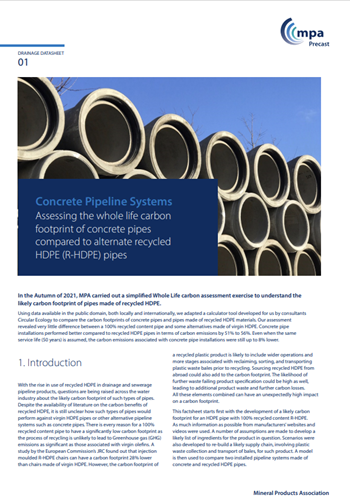
A recently published MPA Precast report shines a light on the embodied carbon benefits of concrete pipeline longevity. When considering material choice for a buried pipe system, a comparison between R-HDPE and concrete pipes should consider service life specifications and the installation impacts of any given scheme. Across the lifespan of a concrete pipeline system the use of an equivalent R-HDPE system could result in a near 50% increase in embodied carbon emissions.
MPA Precast on behalf of the drainage membership has taken a look into the detail of how different life cycles within buried pipe systems in the UK impact the total embodied carbon. Dr Hafiz Elhag, Sustainability Manager for the MPA published his report into R-HDPE vs Concrete Pipe systems in July 2023, bringing his finding to the attention of the drainage sector.
In looking at the total embodied carbon of pipe systems on a like for like basis, one of the pivotable variables is the longevity of concrete systems, covered by A1-A5 & B4 in the Life Cycle stages. This gives a true reflection of how embodied carbon is measured in direct comparison between different materials, with the need to completely replace alternative systems within the same lifespan of a concrete system.
The main conclusion from the study showed a comparative 50% reduction in embodied carbon during the expected lifespan of concrete pipes (rigid pipelines). This demonstratable reduction is a significant saving, showing how a long-term approach to installed systems can reap large scale sustainability benefits for the industry and the built environment.
When looking at distribution to site and the installation phase of any given scheme (A4 & A5), it’s key to note that this additional embodied carbon cost, will be significantly impacted by the necessity to fully replace alternative (non-rigid) pipelines during the equivalent lifespan of a concrete system. In analysing how we can accurately measure the like for like, Dr Elhag found, through industry published data, that specifications for recycled plastic alternatives had a 50% lower expected operational life due to these replacement necessities.
The alternative is unsustainable, systems beyond their lifespan are not only inefficient, but the knock-on impact in terms of carbon ‘cost’ to keep them operational can be greater than just replacing them wholesale.
In introducing a second installation during the same timeframe as a concrete system, we also introduce a range of adverse secondary impacts. Delays, inclement weather, unexpected site constraints can all further impact the construction programme and increase the embodied carbon of the project.
A second round of installation works will also create additional environmental problems at a local level. This could take the form of dust, noise, air quality concerns from construction traffic, even impacts on local water courses. A responsible construction industry is increasing aware of its need to not only drive out embodied carbon of the product but also protect local residents and the environment.
Commercial factors are also key to understanding why a long-term methodology would be a far more sustainable and pragmatic approach to the laying of pipes, and further to the built environment. In any aspect of construction, we talk about maintenance periods and while these are critical to lifespan, we have to accept that a product will come to the end of its serviceable life. The inherent properties of precast products will lower costs and provide certainty by not requiring a second installation period.
The conclusion of this study is that taking the long-term approach will not just significantly reduce the embodied carbon of pipeline systems, it can mitigate and reduce some of the negative aspects of further environmental, cost and human related effects. Given the outcome of this study, a holistic approach, selecting the most efficient and durable option at initial stages, is one that should be the first choice for the industry.